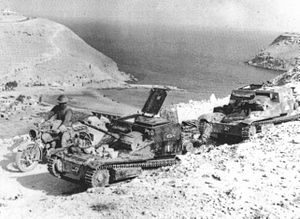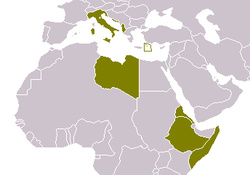- Maletti Group
-
The Maletti Group (Raggruppamento Maletti) was an ad hoc "mechanized" unit formed by the Italian Royal Army (Regio Esercito) in Italian North Africa (Africa Settentrionale Italiana, or ASI) during the initial stages of the Western Desert Campaign of World War II. The group was formed in June 1940 and was destroyed in December of the same year.
Contents
Western Desert Campaign
The Maletti Group was commanded by General Pietro Maletti and was part of the Libyan Corps, also known as the "Royal Corps of Libyan Colonial Troops" (Regio Corpo Truppe Coloniali della Libia). The group itself was composed of six battalions of Libyan infantry and of two battalions of armor. The 2,500 Libyans were "mechanized" in that they were transported in trucks. One armor battalion had thirty-five L3/33 and/or L3/35 tankettes. The other had thirty-five M11/39 medium tanks.[1]
During the very early stages of the North African Campaign, the Maletti Group took part offensively in the Italian invasion of Egypt and defensively during the British counterattack known as Operation Compass. In September 1940, the group acted as a flank guard and led the Italian advance from Libya into Egypt.[2] By December, the group was in defensive positions at the Nibiewa Camp near Sidi Barrani. Many of the armored vehicles were "dug in" and acted as stationary pillboxes.
The Maletti group was considered the 3rd Libyan Division in the initial Italian attack to Egypt, together with the 1st Libyan Division Sibelle and the 2 Libyan Division Pescatori.
The Maletti Group was earmarked for early destruction by the British. During the initial attack, Matilda infantry tanks of the 7th Royal Tank Regiment exploited a hole in the Italian defensive positions and attacked the Nibiewa camp from the rear. The Maletti Group was destroyed and General Pietro Maletti was killed in action while trying to stop the sudden attack:
The initial British assault would fall on Nibeiwa Camp, where the only available Italian armoured unit was based, and it achieved complete surprise. Raggruppamento Maletti, or Maletti Group, under General Maletti, was an ad hoc formation consisting of 2,500 Libyan soldiers and 2 Armoured Battalion, with thirty-five M11/39 medium tanks and thirty-five L3/35 light tanks. It was earmarked for early destruction in the assault, which commenced at 05:00hr with what appeared to be no more than another raid on the eastern side of the camp. At 07:00, however, forty-eight Matilda tanks suddenly appeared from the opposite side of the camp. They struck twenty-three unmanned M11/39 tanks of the Maletti Group, which had been deployed to guard the unmined entrance to the camp. The Italians were caught completely off guard and many did not even reach their tanks, including General Maletti, who was killed emerging from his dugout. They were slaughtered and their vehicles destroyed by the British in less than ten minutes. The Italian artillery fought on valiantly, firing on the Matildas and recording many hits, some at point-blank range - but none penetrated their 70 mm of armour. The remaining Italian tanks were captured intact, and the Libyan infantry, left practically defenceless, quickly surrendered. The British had captured Nibeiwa and destroyed the only front-line Italian armoured unit in less than five hours.[3]The Operation Compass attack on Maletti Group was supported by 25 pounder artillery and Blenheim bombers and was centred on the advance of Mk.II Matilda tanks. Within an hour of the onset of combat Italian General Pietro Maletti was dead and 4,000 Italian soldiers (most of them Libyan colonial troops) had surrendered. Within three days, the attacking forces then moved west along the Via della Vittoria, through the Halfaya Pass and captured Fort Capuzzo, Libya.
See also
- Pietro Maletti
- Military history of Italy during World War II
- Motorised infantry
- 7th Royal Tank Regiment
- 4th Indian Infantry Division
- 1st Libyan Division Sibelle
- 2 Libyan Division Pescatori
References
Sources
- Macksey, Major Kenneth (1971). Beda Fomm: Classic Victory. Ballentine's Illustrated History of the Violent Century, Battle Book Number 22. Ballantine Books.
- Walker, Ian W. (2003). Iron Hulls, Iron Hearts : Mussolini's elite armoured divisions in North Africa. Marlborough: Crowood. ISBN 1-86126-646-4.
- Wavell, Archibald (1946). Despatch on Operations in the Middle East From August, 1939 to November, 1940. London: War Office. in London Gazette: (Supplement) no. 37609. pp. 2997–3006. 13 June 1946. Retrieved 2009-10-31.
- Wavell, Archibald (1946). Despatch on Operations in the Western Desert From 7th December, 1940 to 7th February 1941. London: War Office. in London Gazette: (Supplement) no. 37628. pp. 3261–3269. 26 June 1946. Retrieved 2009-10-31.
- Walker, Ian W. Iron hulls, iron hearts: Mussolini's elite armoured divisions in North Africa. Crowood. Marlborough, 2003 ISBN 978-1-86126-646-0.
External links
- "Archibald Wavell's Despatch on Operations in the Middle East From August, 1939 to November, 1940.". Supplement to the London Gazette, Number 37609. June 13, 1946. http://www.ibiblio.net/hyperwar/UN/UK/LondonGazette/37609.pdf. Retrieved October 31, 2009.
- "Archibald Wavell's Despatch on Operations in the Western Desert From 7th December, 1940 to 7th February 1941.". Supplement to the London Gazette, Number 37628. June 26, 1946. http://ibiblio.org/hyperwar/UN/UK/LondonGazette/37628.pdf. Retrieved October 31, 2009.
Italian Divisions in World War II Armoured 131 Armoured Division Centauro · 132 Armoured Division Ariete · 133 Armoured Division Littorio · 134 Armoured Divison Freccia · 135 Armoured Divison Ariete II · 136 Armoured Divison Centauro II
Cavalry 1 Cavalry Division Eugenio di Savoia · 2 Cavalry Division Emanuele Filiberto Testa di Ferro · 3 Cavalry Division Amedeo Duca d'Aosta
Alpine Mountain 1 Mountain Infantry Division Superga · 2 Mountain Infantry Division Sforzesca · 3 Mountain Infantry Division Ravenna · 4 Mountain Infantry Division Livorno · 26 Mountain Infantry Division Assietta · 33 Mountain Infantry Division Acqui · 36 Mountain Infantry Division Forlì · 37 Mountain Infantry Division Modena · 59 Mountain Infantry Division Cagliari
Motorised 9 Motorised Division Pasubio · 10 Motorised Division Piave · 16 Motorised Division Pistoia · 17 Motorised Division Pavia · 25 Motorised Division Bologna · 27 Motorised Division Brescia · 52 Motorised Division Torino · 101 Motorised Division Trieste · 102 Motorised Division Trento · 103 Motorised Division Piacenza · 104 Motorised Division Mantova · 105 Motorised Division Rovigo
Infantry 5 Infantry Division Cosseria · 6 Infantry Division Cuneo · 7 Infantry Division Lupi di Toscana · 8 Infantry Division Po · 11 Infantry Division Brennero · 12 Infantry Division Sassari · 13 Infantry Division Re · 14 Infantry Division Isonzo · 15 Infantry Division Bergamo · 18 Infantry Division Messina · 19 Infantry Division Venezia · 20 Infantry Division Friuli · 21 Infantry Division Granatieri di Sardegna · 22 Infantry Division Cacciatori delle Alpi · 23 Infantry Division Ferrara · 24 Infantry Division Pinerolo · 28 Infantry Division Aosta · 29 Infantry Division Piemonte · 30 Infantry Division Sabauda · 31 Infantry Division Calabria · 32 Infantry Division Marche · 38 Infantry Division Puglie · 40 Infantry Division Cacciatori d'Africa · 41 Infantry Division Firenze · 44 Infantry Division Cremona · 47 Infantry Division Bari · 48 Infantry Division Taro · 49 Infantry Division Parma · 50 Infantry Division Regina · 51 Infantry Division Siena · 53 Infantry Division Arezzo · 54 Infantry Division Napoli · 55 Infantry Division Savona · 56 Infantry Division Casale · 57 Infantry Division Lombardia · 58 Infantry Division Legnano · 60 Infantry Division Sabratha · 61 Infantry Division Sirte · 62 Infantry Division Marmarica · 63 Infantry Division Cirene · 64 Infantry Division Catanzaro · 65 Infantry Division Granatieri di Savoia · 136 Infantry Division Giovani Fascisti
Garrison 151 Infantry Division Perugia · 152 Infantry Division Piceno · 153 Infantry Division Macerata · 154 Infantry Division Murge · 155 Infantry Division Emilia · 156 Infantry Division Vicenza · 157 Infantry Division Novara · 158 Infantry Division Zara · 159 Infantry Division Veneto
Airborne 184 Airborne Division Nembo · 185 Airborne Division Folgore · 80 Infantry Division La Spezia (Airlanding)
Blackshirt 1 Blackshirt Armoured Division M · 1 Blackshirt Division 23 Marzo · 2 Blackshirt Division 28 Ottobre · 3 Blackshirt Division 21 Aprile · 4 Blackshirt Division 3 Gennaio
Libyan 1 Libyan Division Sibelle · 2 Libyan Division Pescatori · Maletti Group (special unit) ·
Coastal 201 Coastal Division · 202 Coastal Division · 203 Coastal Division · 204 Coastal Division · 205 Coastal Division · 206 Coastal Division · 207 Coastal Division · 208 Coastal Division · 209 Coastal Division · 210 Coastal Division · 211 Coastal Division · 212 Coastal Division · 213 Coastal Division · 214 Coastal Division · 215 Coastal Division · 216 Coastal Division · 220 Coastal Division · 221 Coastal Division · 222 Coastal Division · 223 Coastal Division · 224 Coastal Division · 225 Coastal Division · 226 Coastal Division · 227 Coastal Division · 230 Coastal Division
Categories:- Military units and formations established in 1940
- Military units and formations disestablished in 1940
- Military units and formations of Italy in World War II
- Armoured units and formations
- Military history of Italy during World War II
Wikimedia Foundation. 2010.


